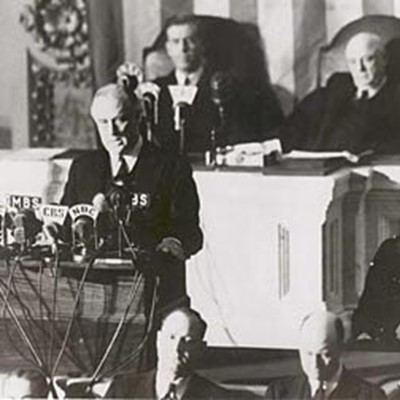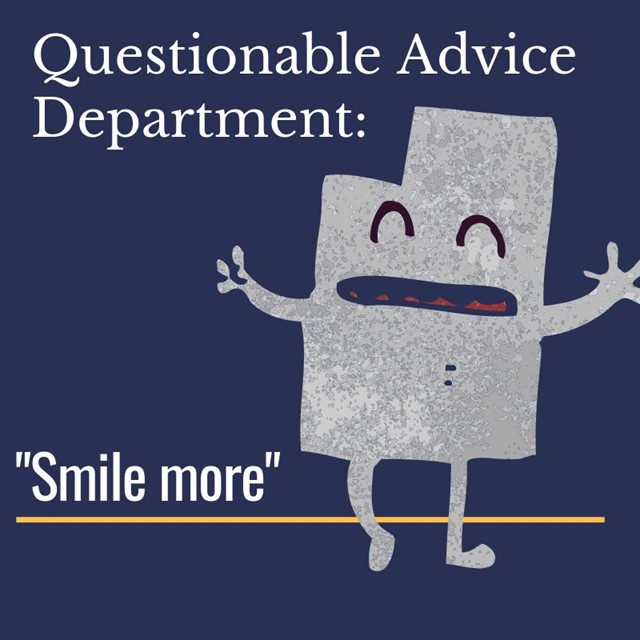
"Did you know your smile can be a predictor of how long you'll live?"
– Intro to a TED Talk on the benefits of smiling
Not too long ago, we worked with the leader of a company. We’d been told—and he’d been told—that our mission was to get him to smile more.
Before he started speaking, we chatted. The leader was friendly, full of personality. He was laughing—and smiling.
Then he stood up to present and his face went flat. No expression.
And his colleague, the one who’d brought us in, said right way: "Come on. We’ve talked about this. You’ve got to smile."
Perhaps you can guess what happened next:
A great deal of frowning ensued.
"I’m just not a smiley guy," he concluded, even though we’d just seen his big, brilliant smile minutes before he started the presentation.
"If you smile when no one else is around, you really mean it."
– Beloved curmudgeon Andy Rooney
Why “smile more” makes them smile less
It’s common advice to speakers: Smile! Let the audience see your warmth! A smile communicates your appreciation for their attention. A smile makes you look confident and more approachable.
There’s even a popular TED Talk about why smiling is a superpower that can bring you as much joy as chocolate, without the calories.
So why do we include this in our “questionable advice” department? Because we’ve seen what can happen when you tell speakers to smile more:
- Forced smiles that look uncomfortable, or worse, like a grimace
- A determination to never smile if it kills them
- High degrees of self-consciousness that don’t help anyone feel happy
Solving the real problem
The request isn’t wrong—but it’s often the wrong way to tackle the problem. Because the real problem is that speakers need facial expressions that communicate their emotions, match their feelings about their messages, and indicate how they want to relate to the audience.
Some of those facial expressions might indeed be smiles.
Instead of asking speakers to smile more, we suggest you might:
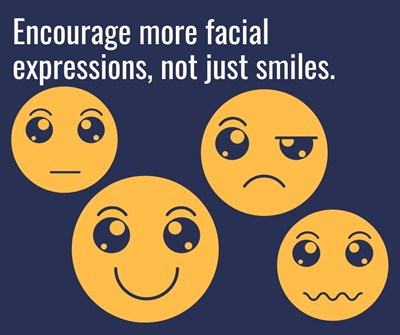
1. Ask speakers to show us more expression in their faces.
Explain that audiences read speakers as much as they listen to them. To help the audience grasp the message, the speaker has to give cues—and facial expressions are a big cue.
It’s hard to believe, for example, that a CEO is excited about a merger if she’s frowning the whole time she talks about it. Likewise, it’s hard to believe the HR director takes stricter work attire guidelines seriously if he’s grinning the whole time he presents them.
Facial expressions that match the message lend credibility to speakers. They make speakers look more authentic, not less so.
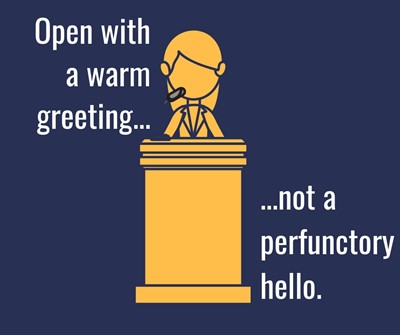
2. Open with a genuine, warm greeting.
If the speaker needs to smile when she greets the audience, help her craft an open that is more than a perfunctory “I’m happy to be here.”
Make the greeting specific to the situation and the audience. Help the self-conscious smiler shift the attention off of her and onto the audience or topic.
Digging a little deeper for a better open could include:
- Starting with a compelling number or fact: "Five thousand low income families in our community will send a child to college because of…"
- Adding a personal angle that helps the speaker relate to the audience: "Not too long ago, I was sitting where you are…"
- Using a story or example that brings a touch of humor
- Announcing good news or congratulating someone on an accomplishment: "We’re fortunate today to have with us the new employee of the month…"
Of course, the open has to match the situation. As do the facial expressions. When a leader shows up to announce the plant is closing, stories—and smiles—don’t feel appropriate. But a smile to thank people for their hard work does.
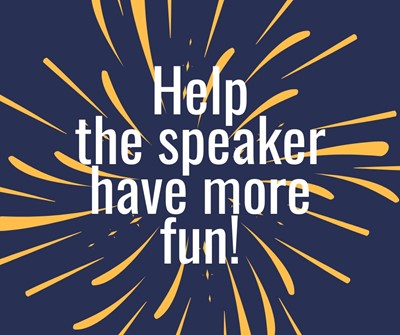
3. When appropriate, find a way to have more fun with the message.
This might include telling a story, adding humor, involving other people in the room, or shifting to a more off-the-cuff conversational style for part of the presentation.
Most speakers—even low-key speakers—are more expressive when they tell a story. Be sure the story has a clear point and that the speaker knows why he’s telling it. Keep the story shorter rather than longer. But when you have a speaker who needs to “smile more,” a story may be the surest route to getting genuine smiles.
A few more thoughts about smiles:
Keep the feedback light: When a person feels pressured to deliver smiles, they rarely do so smilingly.
Consider using video: Often, when a speaker sees how grim he looks, he’ll be motivated to smile more. Something as simple as recording a rehearsal with your phone can go a long way to changing delivery.
Notice what makes the speaker smile: Our coaches watch not just the speaker on stage but also how the speaker expresses himself one-on-one. Create more of those opportunities in the speech, so the smiles come out.
Make sure the smile flashes on, then off: When a smile persists, it starts to look fake.
Make sure the smile is appropriate: When a speaker is being pressured to smile, smiles may pop out that don’t match the message. No one (except the Grinch) wants to grin as they deliver bad news.
And if you need a reason to smile yourself, here's that TED Talk that touts the benefits of turning that frown upside down:


